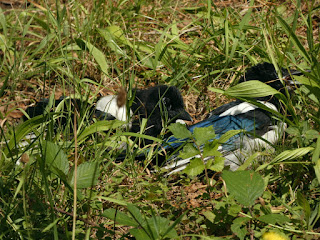The other two are probably their parents, who have shown them the way to the lake.
One of the permanently resident pairs on the Serpentine is the incompetent couple who have never managed to nest, or even to dance properly -- this is today's attempt.
I think this is the couple I saw yesterday trying to build a nest on the moored rowing boats. Today Ahmet Amerikali photographed them desperately trying to start a nest in a hopeless place on the open edge of the lake.
I feel particularly sorry for them because their territory includes an excellent nest site in the reed bed at the east end of the lake, which they could reach by diving under the net surrounding it, which only reaches down to water level so even the smallest chick could get under it. But this has not occurred to them, and there is no way to teach them.
The two grebe chicks on the Long Water were in the shade of a willow tree, from which they occasionally emerged.
The Coots from the east end of the Serpentine were busily feeding their new chicks.
But the nest newly built at the edge of the weir has washed away since I photographed it yesterday.
It was a hot day, and a pair of Moorhens reclined on the edge of the lake. They like to be next to a clump of plants, even a small one, which makes them less likely to be disturbed by an unobservant human runner.
The five Mallard ducklings on the Long Water were diving to fetch up strands of algae.
Two Canada Geese tried out their newly restored flight feathers on the Long Water.
The Egyptian Geese with the adopted gosling had managed to get it back from its wanderings.
But one of its siblings, still with its original family, had now wandered off from its parents and forgotten where they were, and was swimming about piping plaintively. Vagueness is in the genes of this family.
Two Magpies were sprawled under a bush, panting with the heat.
A Long-Tailed Tit was also looking hot. Thanks to Ahmet for this fine picture.
The Little Owls, birds at home around the Mediterranean, were undisturbed by the temperature. This is the male of the pair at the Albert Memorial.
A remarkable find by Ahmet: two fox cubs hiding in the flower bed in front of the Diana memorial. I think they are from the other side of the bridge, where there is a large patch of scrub, and had wandered here and got stuck by the arrival of people in the park. There's plenty of cover here and they should come to no harm.
The hot day brought out a lot of Small Red-Eyed Damselflies in the Italian Garden fountain pools. They were busily mating on the floating algae.














Little Owls like it pretty hot. I am always amazed that they manage to thrive in the UK.
ReplyDeleteI hope the lost little Egyptian will manage to attach itself to any Egyptian brood passing by. In this case, vagueness may play in its favour.
I wish we could see the newcomers flying in. I don't think I have ever seen a Grebe flying in my life.
I cannot help thinking of the incompetent pair which cannot even dance with tenderness and regret.
Grebes can be seen flying occasionally, low over the water. They do any real travelling at night, so you don't see them. I have only seen a grebe flying above head height once, when one flew on to the Serpentine from the Buckingham Palace gardens.
Delete